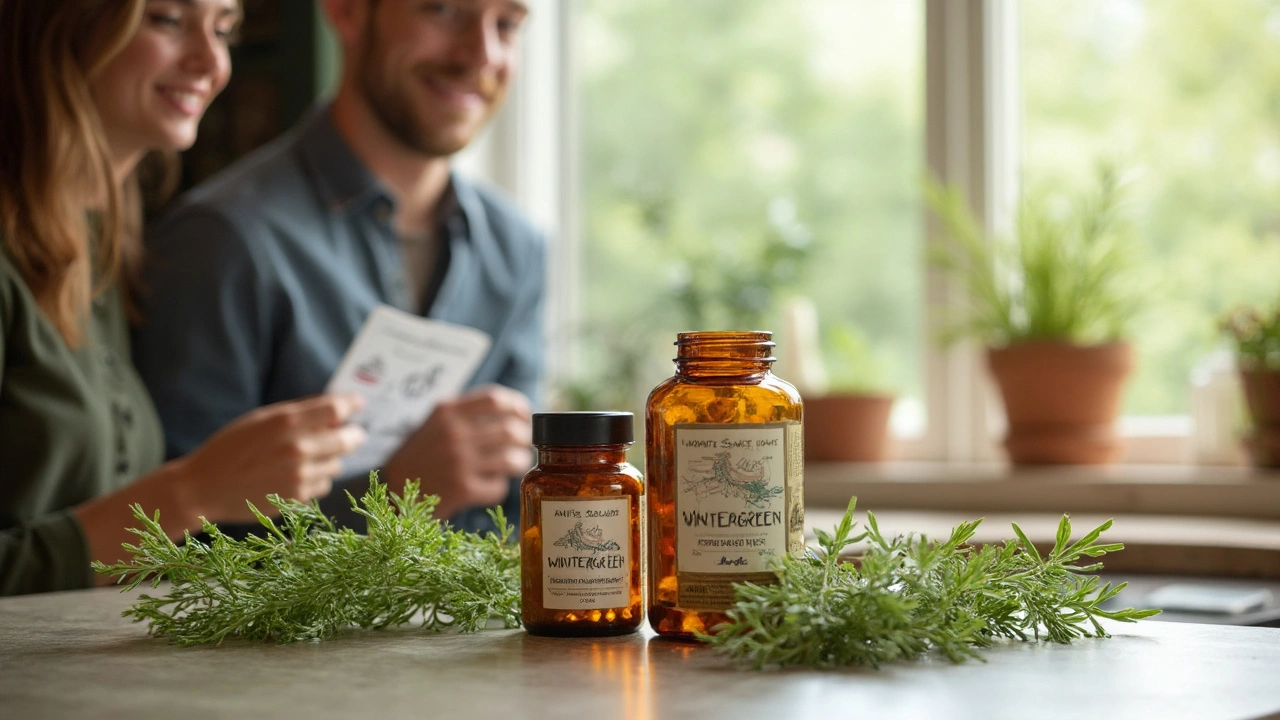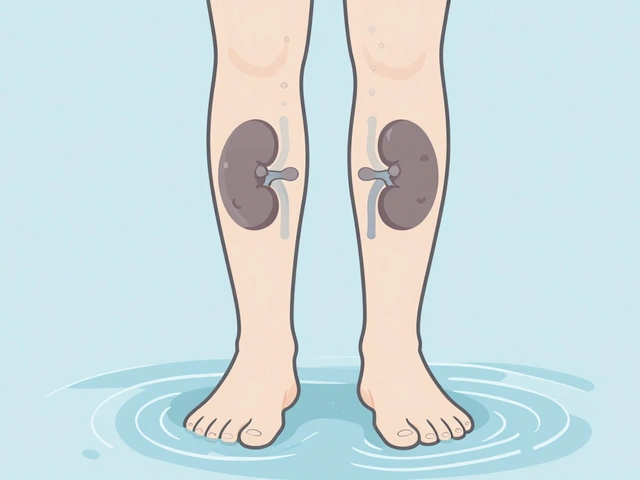Imagine waking up with less pain and more energy, all because of something as simple as wintergreen supplements. Feel skeptical? That's fair—but wintergreen isn't just any herb. It's packed with a powerful punch hiding in plain sight on your supplement shelf. Once just a woodland remedy for bumps and bruises, wintergreen has found its way into modern bottles and capsules, with real potential to shake up how you approach daily health challenges.
What Makes Wintergreen Unique as a Supplement?
At first glance, wintergreen might seem like just another plant. But peel back the layers, and you’ll see that this little green leaf steers clear of being ordinary. Its main active player is methyl salicylate, a compound that behaves a lot like aspirin. Ever used an icy-hot rub or one of those muscle-soothing creams after a tough workout? That tingly sensation often comes from, you guessed it, wintergreen oil.
The punch behind wintergreen supplements isn’t just folklore. Native American folks used wintergreen for centuries to dull headaches, muscle soreness, and even cold symptoms. That wasn’t just tradition—it works thanks to genuine plant chemistry. Modern studies point out how methyl salicylate actually reduces inflammation by blocking specific enzymes, much like over-the-counter pain relievers. The difference? It grows on a low shrub instead of coming from a lab. This makes wintergreen one of the rare supplements that brings together old-school wisdom and 21st-century practicality.
Wintergreen isn’t a one-trick pony, either. It's loaded with antioxidants, those tiny defenders that shield your body from oxidative stress. Think of oxidative stress as the rust that creeps up on machines. In our bodies, this 'rust' shows up as skin aging, higher disease risk, and drained energy. The antioxidants in wintergreen help mop up free radicals, so you feel fresher and recover faster, whether from a long day or a surprisingly hard run.
But here’s something you rarely see discussed: wintergreen doesn’t flood your system with its active compound. Instead, the body converts methyl salicylate into salicylic acid after digestion, offering a slower, steady action that may mean fewer ups and downs for sensitive people. That slow-but-steady approach makes it popular with folks who want consistent relief minus the gut punch of some harsher painkillers.
Looking at it in the modern supplement aisle, wintergreen is usually available as capsules, softgels, or blended formulas aimed at joint comfort or muscle support. Labels often mention “standardized methyl salicylate content,” which means you know what you’re getting in each dose. That kind of consistency matters, especially when you’re looking to avoid the wild cards of unregulated herbals.
Still, as tempting as it is to imagine wintergreen as a cure-all, it’s best used as part of a balanced routine. Its power comes from teamwork—boosted even more when you’re making other smart choices with diet, movement, and stress management. Treat it like a tool in your wellness toolkit, rather than a magic bullet, and you’re on your way to seeing why so many folks are turning to this tiny green wonder.
The Science Behind Wintergreen’s Health Benefits
Wintergreen doesn’t just have a cool-sounding name; scientists have been poking and prodding this plant for decades to see what it can offer. The spotlight often lands on that standout compound, methyl salicylate. This ingredient acts in a way very similar to nonsteroidal anti-inflammatory drugs (NSAIDs), which millions of people take for joint pain, arthritis, or injuries. When you pop a wintergreen supplement, your body transforms methyl salicylate into salicylic acid, a close chemical cousin to aspirin.
If you dig into the numbers, the Journal of Natural Products shared a study where wintergreen extract was tested on human immune cells. At measured doses, it reduced cell inflammation markers by up to 60%, lining up neatly with what’s seen from familiar over-the-counter analgesics. Other research—especially small studies in athletes and people with chronic back pain—shows lessened muscle soreness and faster recovery simply by using wintergreen-based products (supplements and topical alike).
That’s not the only trick up wintergreen’s sleeve. It also offers a sweep of antioxidant activity. A recent laboratory study out of South Korea found that the polyphenols in wintergreen had a significant ability to scavenge free radicals—reducing oxidative stress levels by about 35% compared to untreated samples. This matters if you’re dealing with daily exposure to pollution, junk food, or just plain old stress (which, let’s face it, is pretty much everyone with a smartphone these days).
For those attracted to the natural side of medicine, wintergreen’s antimicrobial properties are a surprise bonus. A 2022 in vitro trial looked at wintergreen essential oil and discovered that even small concentrations could knock out some common bacteria, including Staphylococcus aureus and E. coli. This doesn’t mean you should toss your antibiotics—far from it—but it does make wintergreen one of the few supplements with real potential for broad health support.
Of course, it’s important to mention that quality matters. Some supplements are all bark and no bite, with weaker concentrations or untested fillers. High-quality wintergreen products usually share lab results or third-party certifications, so you’re not left guessing. Here’s something many don’t realize: wintergreen can be concentrated a lot, so always check the actual milligram amount per serving. Most adults do well with 50–100 mg of methyl salicylate from capsules, but higher doses should be avoided unless you’re working with a healthcare pro.
Just to make things concrete, check out this wintergreen dietary supplements benefits table, based on up-to-date reviews and studies:
| Benefit | How Wintergreen Works | Typical Result |
|---|---|---|
| Pain Relief | Blocks prostaglandin enzymes (like NSAIDs) | Reduced joint and muscle pain |
| Anti-inflammatory | Decreases immune cell inflammation markers | Faster recovery after exercise or injury |
| Antioxidant | Polyphenols mop up free radicals | Lowered oxidative stress, improved energy |
| Antimicrobial | Disrupts bacteria cell membranes | Helps keep minor infections in check |
One thing folks love about wintergreen: it runs gentle but deep, acting as a steady hand for your daily aches without the gut issues some synthetic painkillers carry. But as with any supplement, respecting the recommended dose and knowing your own sensitivities is key—no shortcuts here.

Tips for Safely Using Wintergreen Supplements
Clever marketing will tell you almost anything to get your attention, but when you start thinking about actually taking wintergreen, there’s smart and then there’s wise. A few straightforward tips can keep things safe and actually help you to get more out of your supplement game.
- Choose the right dose: Ignore the “more is better” trap. For most people, 50–100 mg of methyl salicylate per day is effective. Taking more can lead to stomach upset, irritation, or even toxicity—especially if you’re already taking aspirin or blood thinners. Always read the label and avoid stacking products unless your doctor gives the green light.
- Watch for real quality: Check for brands that boast third-party lab testing. Some include QR codes on the label linking directly to lab results. You want no pesticides, accurate mg per capsule, and nothing weird lurking in the 'other ingredients' section.
- Know your allergies: If you’re sensitive to aspirin, steer clear—your body processes both in a similar way. Same goes for people with bleeding disorders or ulcers. If you have a complicated medical history, a quick chat with your doctor or pharmacist before jumping in is just plain smart.
- Take it with food: A lot of GI upsets from herbal supplements come from taking them on an empty stomach. Grab your wintergreen dose with breakfast or a post-workout snack and you’re much less likely to feel queasy.
- Pair it with the right habits: No supplement gets you off the hook for avoiding junk food and sedentary days. Wintergreen shows its true colors when you’re moving, eating well, and actually giving your body what it needs to heal. Mix it with gentle exercise or stretching, and you’ll likely notice bigger improvements.
- Look for combination products: Some joint or muscle health supplements blend wintergreen with turmeric, ginger, or omega-3s. These combos often work better than stand-alone stuff, thanks to the way plant compounds team up in your system. Again, just check dosing to avoid overlaps.
- Don’t expect miracles overnight: Plants work on the body at their own pace. Results often show up after steady use—think a week or two, not a couple of hours. Track changes in your pain, flexibility, or even sleep to catch the differences over time.
People who use wintergreen the right way tend to report steady improvements—instead of chasing spikes and crashes. And unlike prescription meds, wintergreen rarely causes dependence, which is a huge relief for folks scared of getting caught up in that loop.
For athletes, or anyone dealing with lots of movement, cycling wintergreen (e.g., three weeks on, one week off) can keep sensitivity low while keeping results high. This gives your body a break and helps keep any minor irritations from creeping up.
Just remember: wintergreen is strong, no matter how natural it is. That means storage matters. Keep capsules in a cool, dark spot so the methyl salicylate stays stable, and always toss any supplement past its expiration date. Freshness counts, and it can mean the difference between something that works and something that’s just taking up bathroom cabinet space.
How to Work Wintergreen Into a Real-Life Wellness Routine
It’s easy to grab a bottle, pop a pill, and hope for the best. But to really see what wintergreen can do for you, it pays to bring a bit of strategy to your daily health plan.
Start with what already hurts. Got a stiff neck from working on a laptop all day? Maybe it’s those old running knees acting up in the morning. Jot down your worst trouble spots and rate your typical pain or discomfort, just to give yourself a baseline. This makes it a lot easier to track actual changes when you try wintergreen.
Think about when you hurt the most—after your morning jog, at the end of a long shift, or right before bedtime. Slot your wintergreen supplement into this window, always paired with a little food. The idea: time your dose so it cushions these challenging moments, rather than tossing it in at random and waiting for luck.
Double down by stacking habits: combine wintergreen use with light stretching, a brief walk, or a heat/ice routine. This is where real magic happens. Wintergreen tunes down pain and inflammation, while movement or temperature therapy help your body reset. Over a week or two, this tag team can get you moving better or sleeping more soundly—sometimes for the first time in ages.
If you’re already taking other supplements—say, turmeric for inflammation or magnesium for muscle cramps—give your doctor or pharmacist a quick rundown to check for interactions. Most natural blends play nicely, but methyl salicylate can theoretically amp up the effects of blood thinners or NSAIDs, so a safety check is smart. Don’t leave it to chance.
Seasonal aches? Wintergreen has a special place in the cold-weather toolkit. It was used for years by farmers and laborers who braved winter chills and damp mornings. Pop your wintergreen supplement just before tackling cold-weather yard work, or prepping for an early morning gym session—the plant is legendary for helping folks dodge those midday back aches that ruin a perfectly good winter day.
Don’t underestimate the mental boost, either. Folks who lean into wintergreen use often find that less pain equals better sleep, better moods, and way more energy for daily stuff. Instead of burning out by lunchtime, you might actually finish your workday with juice left over for a walk, hobby, or extra time with your kids.
And if you slide off track, don’t stress. Wintergreen isn’t a habit-former, and you won’t crash if you miss a day or two. Just jump back in when you’re ready, and pick up where you left off. That’s why real people stick with wintergreen—because it fits around life rather than forcing you to fit around it.







Brenda Martinez
July 18, 2025 AT 13:17Okay, I have to say, wintergreen supplements are one of those things that sound too good to be true, but actually aren't! I've always had a soft spot for natural remedies, but this one? It's like a magic potion for pain and inflammation. The compounds inside are pretty powerful, and honestly, it's such a relief to find something that helps without piling on chemicals.
But please, don’t just dive in blind. The article’s right that you need to be careful and know exactly what you’re taking. Wintergreen oil can be super strong and toxic if misused, so supplements are definitely the safer route. Still, talk to your doc before starting! I’ve seen folks get overwhelmed with DIY ideas, and that can go sideways fast.
Has anyone tried wintergreen for muscle soreness? I’m curious if it really beats other meds. I’m ready to swap out my usual stuff if this works better. Honestly, wellness should be about smart choices like this!
charlise webster
July 19, 2025 AT 20:33I'm skeptical about these so-called 'miracle' supplements. Wintergreen's benefits get hyped a lot, but isn't there a lack of long-term clinical data backing all of this up? Pain and inflammation are complicated issues, and relying solely on a herb-based supplement sounds like oversimplifying to me.
Plus, essential oils and extracts can cause allergies or interactions with other medications. I think people should approach with caution and demand more robust research before jumping on the bandwagon.
But hey, if it works as advertised, I’d like to see some concrete evidence too. Until then, I remain unconvinced.
lata Kide
July 20, 2025 AT 10:26OMG, seriously, this wintergreen thing is EVERYTHING! I started taking these supplements last month, and honestly, the difference is like night and day! 🌙 My joint pain has calmed down so much, I’m almost crying from relief! 😭💪
But wait, the drama doesn’t stop there — you HAVE to watch your dose because too much can trigger side effects, and nobody wants that kind of chaos. I read some reviews where people didn’t follow the directions, and they almost had a meltdown. Be smart, friends. 🧠✨
Honestly, why isn’t everyone talking about this? It’s like the wellness world’s best-kept secret. Also, does anyone mix it with other herbs? Curious about combos! 😍
Mark Eddinger
July 21, 2025 AT 14:13From a scientific standpoint, the active compound methyl salicylate found in wintergreen is well-documented for its analgesic and anti-inflammatory properties, similar in effect to aspirin. However, one must recognize the importance of proper dosing. Excessive intake may lead to toxicity. The article does a commendable job in highlighting the need for caution.
Moreover, users should be advised to avoid direct topical application of pure wintergreen essential oil and to consult healthcare professionals prior to supplementation, particularly those with pre-existing medical conditions or those on concurrent medications.
Further clinical trials would be valuable in substantiating these claims with rigorous data.
Francisco Garcia
July 22, 2025 AT 18:00This post really got me thinking about the cultural perspectives on wellness supplements, especially ones like wintergreen that blend traditional herbal practices with modern supplement trends.
In many societies, natural oleoresins like wintergreen have long been used medicinally, and it's fascinating to see them gaining new life in today's health market. I wonder how regulatory frameworks in different countries handle these and whether consumers are adequately educated globally.
Also, curious if anyone here has insights or experiences with wintergreen supplements from a cultural or regional usage perspective. It's always enlightening to hear how these remedies fit into diverse health practices.
Patrick Renneker
July 23, 2025 AT 21:46Allow me to assert that while the purported advantages of wintergreen supplements may capture the imagination of the casual wellness enthusiast, it is incumbent upon us to maintain a stance of rigorous skepticism. The notion that an organic substance can simultaneously alleviate pain and inflammation with minimal side effects strains credulity without the support of sustained, peer-reviewed research.
The article glosses over potential contraindications and fails to emphasize the necessity for strict dosage control, which, given the biochemistry of compounds such as methyl salicylate, is an oversight of considerable gravity.
Thus, one must proceed with considerable caution and seek expert medical consultation before entertaining the use of such supplements.
KAYLEE MCDONALD
July 25, 2025 AT 01:33Hey everyone, just jumping in to remind folks that while supplements like wintergreen can be a real help, listening to your body is key. If something doesn’t feel right, stop. Don’t push through discomfort or ignore new symptoms.
It’s also worth pointing out the importance of consulting your healthcare provider before starting this or any supplement, especially if you’re dealing with chronic conditions or taking medications. Safety first.
That said, for many, this could be a great option to support wellness. Just stay aware and don’t hesitate to ask questions!
Alec McCoy
July 26, 2025 AT 05:20It's truly inspiring to see more natural options like wintergreen supplements entering the spotlight. From my experience mentoring folks in health journeys, integrating such supplements can offer holistic benefits when paired with balanced nutrition and exercise.
The key is personalization — what works wonders for one might be less effective for another. I'm curious how others have adapted their routines with wintergreen, especially in managing inflammation?
Let’s keep encouraging open dialogue, sharing what works and what doesn’t, to empower everyone to achieve their best wellness.
Aaron Perez
July 27, 2025 AT 09:06Now let us not be so naive as to assume that this so-called "natural remedy" isn't just another cog in the great machine of pharmaceutical capitalism designed to placate the masses!!! Seriously, methyl salicylate in wintergreen is structurally related to aspirin, a synthesized compound with a precise dosage - we call that chemistry, not magic.
If someone thinks popping a supplement labeled 'natural' exempts them from side effects or interactions, they are dangerously deluded. And people wonder why misinformation spreads like wildfire! Consider too the socio-economic constructs leading to reliance on these quick-fix supplements rather than addressing systemic health determinants.
Wake up, critical thinkers!
William Mack
August 1, 2025 AT 00:13Interesting discussion so far. I’m curious, for those who have tried wintergreen supplements, have you noticed differences in dosage forms, like capsules versus topical creams? Does the efficacy vary significantly depending on method of intake?
Also, how do you personally mitigate potential side effects? Are there particular brands or formulations you trust more due to ingredient purity or third-party testing? I believe practical user feedback could be really valuable here.
Evan Riley
August 17, 2025 AT 05:06You folks talking about "natural benefits" and "scientific caution"... wake up!!! Have you ever stopped to think why these supplements are suddenly booming? It's a convenient distraction orchestrated by shadowy interests to keep us hooked on consumables instead of real cures.
Wintergreen? Just a chemical agent repackaged. It’s all part of a massive cover-up to prevent true healing knowledge from spreading. The big pharma wants people confused and dependent.
Check the patents. Check the $$$ flow. They don't want people getting better, just keeping them coming back for more. I'm telling you, start questioning everything!